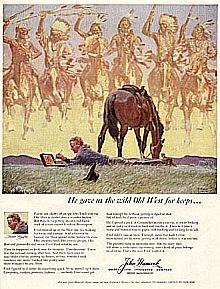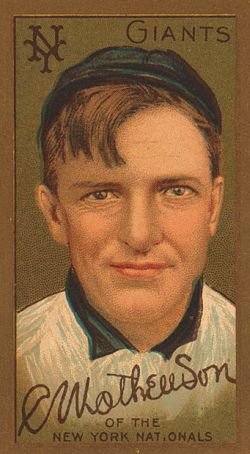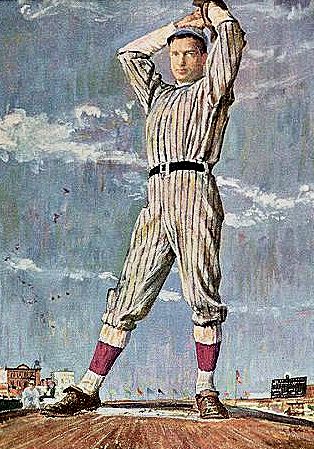
Close-up artist’s rendition of baseball great, Christy Mathewson, for John Hancock Insurance Co. ad, 1958.
John Hancock, to be sure, was basking in a kind of positive association for telling the much-loved tales, and some of the ads ran with a shorter, adjacent-page column from a John Hancock official making a soft-sell pitch for life insurance. Still, the featured full-page ads were classy pieces of advertising; often done with a handsome original color illustration using known and unknown artists, some venerating history, individualism, character, etc., and most offering educational benefit as well. They appeared only once or a few times at most in the magazines of the day. Consequently, today, original copies of these ads are regarded as collector’s items, often showing up at auction houses or on E-bay. One of the John Hancock ads from the late 1950s features the famous baseball player Christy Mathewson, shown above. The image is a close-up from its full-page layout, which is shown below. In the narrative copy for this ad, also included below, John Hancock offers a commentary on Mathewson’s career and personality. Mathewson was one of the all-time great baseball pitchers who played most of his storied career with the New York Giants (also called the Nationals) between1900–1916. He was also one of the first five players to be inducted into the baseball Hall of Fame. More about Mathewson follows shortly, but first the John Hancock ad as it ran in 1958.
|
“He had more on the ball than a ‘fade away’…” 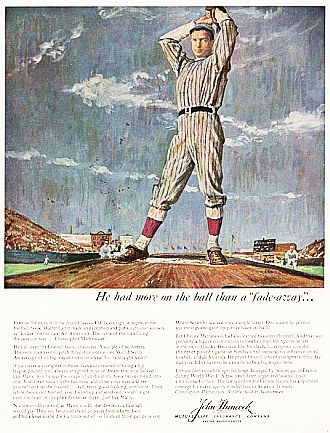 In the 1940s and 1950s, John Hancock Life Insurance ads used history and famous people from sports, business, politics & the arts to help burnish its reputation. “Part of the story is in the record books. Oddly enough, it began in the football book. Walter Camp made an exception and put an 11th man known as “kicker” on his 1900 All-American [football team]. The name of the man filling the position was…Christopher Mathewson! “He’s all over the baseball book, of course. A couple of no-hitters. The only man ever to pitch three shut outs in one World Series. An average of 17 big league victories a year for 12 straight years! … If you were a youngster in those years and dreamed of being a big league pitcher, you always imagined in your dream that you looked like Matty. For he was the image of all the story-book heroes rolled into one. You’d lean back on the haymow and close your eyes and see yourself on the mound… tall, trim, good looking, confident. Then, while the crowd hushed, you’d wind up and send one ‘swish’ right over the heart of the plate for strike three. Just like Matty. 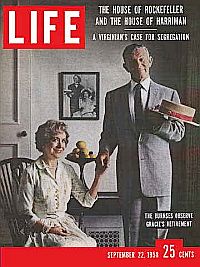 Life magazine cover, Sept 22, 1958, featuring George & Gracie Allen. “But Christy Mathewson also learned to control himself. And that was probably a bigger contribution to baseball than the figures he left in the record books. His clean life, his ideals, his religious scruples (he never played a game on Sunday) had tremendous influence on all baseball, and all America. He proved to millions of youngsters of his day that you didn’t have to be a rowdy to be a big league hero.” “Christy died in middle age, his lungs damaged by poison gas in France during World War I. A few years later organized baseball built a memorial for him. The last word on the bronze plaque has a splendid message for every sports-minded boy in America. It reads… Christopher Mathewson: Athlete, Soldier, Gentlemen.” – John Hancock Mutual Life Insurance Co. 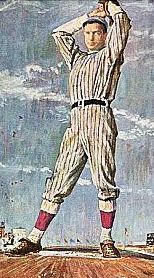 John Hancock's "pitch"... “One quality seems to be common to most of the men who have been featured in our series about great Americans. In their lives, you can see CHARACTER. Most of these men who accomplished great deeds were also men of decency and honesty, and of perseverance. “We have always believed that character is all-important in the life insurance business. Counseling a family on its life insurance needs is a serious affair. . . We go to great lengths to make sure that John Hancock agents have skill and knowledge. We are them with the finest, most modern policies. Above all, in their selection, we seek character. “When a man buys life insurance for his family, this too is a mark of character. . . of how seriously he considers his family’s well being…how willingly he looks beyond today, to provide for tomorrow.” |
Christy Mathewson
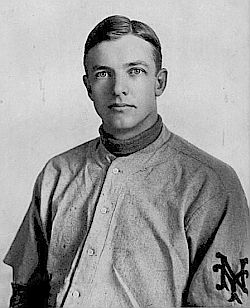
Photograph of a young Christy Mathewson, circa early 1900s, in his New York uniform.
During a 17-year career, Mathewson won 373 games and lost 188 for an outstanding .665 winning percentage. His career ERA – earned run average – of 2.13 and 79 career shutouts are among the best all-time for pitchers. And his 373 wins is still No. 1 in the National League, tied with Grover Cleveland Alexander.
Using his famous fade-away pitch, “Matty” won at least 22 games twelve straight years beginning in 1903 – winning 30 games or more four times. A participant in four World Series, Mathewson set an especially distinctive World Series mark in 1905 when he threw three shutouts in six days against the Philadelphia Athletics. He also set the modern National League record for most games won in a single season; 37 in 1908 – quite extraordinary, then and now.
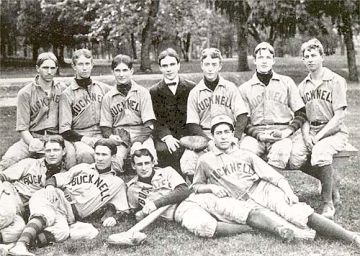
1901 Bucknell University baseball team with Christy Mathewson in the back row, second from right.
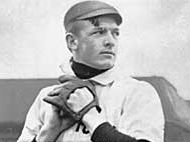
Christy Mathewson & spare mitt...
In his first years in the major leagues, he bounced around for a time between the New York Giants and the Cincinnati Reds, but finally settled in the with the Giants where he would remain until 1916. With the Giants, he played under manager John McGraw, one of baseball’s feistiest competitors, but a manager who also took a special liking to Mathewson. Through the years, though quite different, the two men became friends and would help change the game of baseball. Mathewson, for his part, would become a role model to young boys, a charge he took quite seriously, as noted in one statement he made:
“First of all, no one can live up to everything that’s been written or said about me. And, I keep to myself. I’m a private man. Yet, because I pitch for the New York Giants, I realize that I’m able to reach more young men than the President of the United States. That’s not due to the fact that I’m more popular than Mr. Taft – I don’t believe – but, it’s a fact boys would rather read about yesterday afternoon’s event at the Polo Grounds. Because of that, I feel very strongly that it is my duty to show those youth the good, clean, honest values that I was taught by my Mother when I was a youngster. That, really, is all I can do.”

Christy Mathewson, further along in his baseball career, in his New York Giants uniform.
Mathewson was also a devout Christian, never pitching on a Sunday, and was sometimes called “The Christian Gentleman.” Others lauded Mathewson’s “model citizen” status and off-the-field contributions. Grantland Rice, the famous sportswriter whose work appeared in the New York Herald Tribune and elsewhere, noted: “Christy Mathewson brought something to baseball no one else had ever given the game. He handed the game a certain touch of class, an indefinable lift in culture, brains and personality.” Mathewson’s various character qualities, his college education, his good looks, and his moral stance on no Sunday pitching, gave him a much-admired standing in American public opinion.
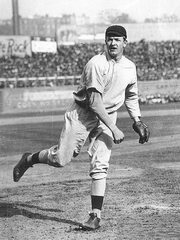
Christy Mathewson at work.
In 1903, 1904, and 1905 Christy Mathewson won 30 or more games each year. In 1903, he had 267 strikeouts, a National League record that stood until Sandy Koufax broke it with 269 strikeouts in 1961. But 1905 was an especially impressive year for Mathewson, as he won the National League Triple Crown for pitchers that year – i.e., wins (31-9), strikeouts (206) and ERA (1.28). He also threw his second no-hitter that year. But in the World Series that fall against the Philadelphia Athletics, the 25 year-old pitching ace was even more impressive. He was the starting pitcher for the Giants in Game 1 and pitched a four-hit shutout for the victory. Three days later, with the series tied at 1–1, he pitched another four-hit shutout. Then, two days after than, in Game 5, he threw a six-hit shutout to clinch the series for the Giants. In a span of six days, Mathewson had pitched three complete games without allowing a run.

Baseball’s Christy Mathewson in his notable over-the-head windup.
In 1906 Mathewson came down with diphtheria and nearly died. Still, he finished the baseball season that year with a 22-12 record. His best year was still to come. In 1908, he recorded his record-setting 37 wins in a single season, also claiming the Triple Crown that year. His ERA that year was an incredible 1.43. The Giants, however, finished behind the Chicago Cubs.
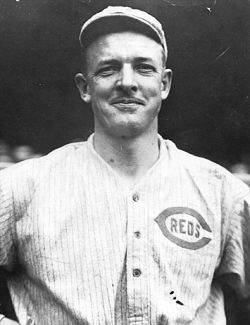
Christy Mathewson, circa 1916-17, with the Cincinnati Reds.
In 1919-1920, he returned to baseball, serving as a coach for the New York Giants. At about this time, he also began spending time in upstate New York at clean-air “cure cottages” in Saranac Lake fighting his lung disease. In 1923, Mathewson served as part-time president of the Boston Braves. Two years later, in October 1925, he died at Saranac Lake. He was 45 years old. Christy Mathewson is buried at Lewisburg Cemetery in Lewisburg, Pennsylvania.
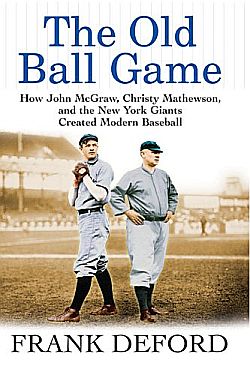
Frank Deford’s book explores how Christy Mathewson and John McGraw influenced modern baseball. Click for copy.
Although Christy Mathewson played in what is sometimes known as the dead ball era – before home run hitting and offense generally became prominent in a more lively ball era – his pitching, combined with the managing of John McGraw at the New York Giants, helped produce what some have called the modern baseball era, and along with it, some of the game’s first stars and heroes. Mathewson was certainly among a handful of “star” players in those years; stars who were helping improve the popular appeal of baseball. This was occurring just as an American middle class was taking form. Baseball was becoming more of a bigger business by then — especially championship baseball. Between 1904 and 1913, Mathewson and McGraw took the Giants to five National League pennants, boosting attendance and revenue for the Giants’ franchise, suggesting new business possibilities for all of baseball. In those years, Mathewson and McGraw — as well as other “stars” then engaged in pennant races and World Series play — became famous Americans. McGraw would outdistance Mathewson in the game, completing a 31-year career as manager in 1933, taking his teams to 10 National League pennants and three World Series. But Christy Mathewson was McGraw’s shining star in the first part of that era. Between them — along with other stars of that era — they helped elevate baseball to its national pastime stature, and they also helped to make baseball more a part of popular culture, drawing more general interest in the game and its players. At least one book of recent vintage, The Old Ball Game by Frank Deford, displayed above, explores some of that history, and there are no doubt others as well.
After his passing, Christy Mathewson would earn a range of professional kudos for his play. In 1936, he was voted into the Baseball Hall of Fame – one of the famous “First Five’” inductees, along with Babe Ruth, Ty Cobb, Walter Johnson and Honus Wagner. Mathewson was the only one of the five who didn’t live to see his induction. But other recognition also came. In 1943, during WW II, a 422-foot Liberty Ship, built in Richmond, California, was named in his honor, the S.S. Christy Mathewson. And periodically, the sports press would do retrospective pieces on Mathewson’s career, such as an October 1949 piece in Sport magazine by Jack Sher entitled, “Christy Mathewson — The Immortal ‘Big Six’.” In 1957, the Christy Mathewson Little League was formed in District 17 of his home state and home town of Factoryville, Pennsylvania. Baseball historians, meanwhile, have marked him among the sport’s greatest players. In 1999, he was ranked No. 7 on The Sporting News list of the 100 Greatest Baseball Players, the highest-ranking National League pitcher on that list. ESPN selected his pitching performance in the 1905 World Series as the greatest playoff performance of all time. Today, in the left-field corner of the San Francisco Giants’ AT&T Park in San Francisco, a replica of his baseball jersey – which in his day, bore no numeral – is formally retired with the designation “NY.”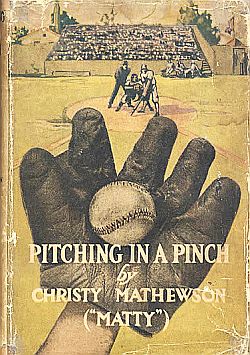
A somewhat weathered and worn cover to Christy Mathewson’s 1912 book, “Pitching in a Pinch,” G.P.Putnam & Sons. Click for Kindle edition.
Christy Mathewson also became something of a writer during his career – or at least had his name attached to several baseball books that appeared and sold quite well in the 1910s. In the winter of 1911 and 1912, Mathewson, wrote a series of baseball stories with the help of newspaper man named John Wheeler. That series was called “Baseball from the Inside.” In 1912, while still an active pitcher, Mathewson compiled the stories with Wheeler for publication as a book, Pitching in a Pinch. Mathewson had described pivotal points in a baseball games as “being in the pinch,” with the outcomes of games often decided on what pitchers especially would do in those moments, thus his book title, Pitching In A Pinch. The Mathewson book, at 304 pages, was first published by G. P. Putnam’s Sons, New York and London. Grosset & Dunlap also did a 1912 dust jacket for the book – believed to be the one displayed at left. One reviewer in the New York Times noted when the book first came out: “Mr. Mathewson uses his pen with cleverness and tells a story remarkably well.” Pitching in a Pinch, in fact, is still in publication today, “rediscovered” in 1977 when it was published in hardcover and paperback editions by Stein and Day. It survives today as a baseball memoir from a professional player providing an inside perspective on the game in those years. Original editions of this book can sometimes do quite well among sports memorabilia collectors. According to Robert Edward Auctions of Watchung, NJ, a copy of a 1912 Putnam edition of Pitching in Pinch, with Christy Mathewson’s signature, sold for $26,437.00 in 2007. Certain vintage Christy Mathewson baseball cards have also been known to fetch substantial amounts at auction.
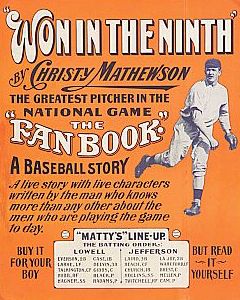
A promotional advertisement for Christy Mathewson’s 1911 book, “Won in the Ninth.”
Won in the Ninth was praised by the critics when it first appeared in 1911, and Mathewson intended the book to be the first of a series. Several others followed, including, First Base Faulkner, Second Base Sloan and Pitcher Pollock.
However, these books appear to have been a collaboration between Mathewson and sportswriter W.W. Aulick, and were more the products of publishers capitalizing on Mathewson’s popularity than they were the writer’s works of art. The publishers, however, appear to have launched some considerable promotional efforts around these books, one example of which is displayed at right. Most of the books can still be found today at online booksellers.
John Hancock, Inc.
The John Hancock Insurance Company, the sponsor of the 1958 Christy Mathewson ad which began this piece, is itself something of a historic entity. The company’s origins date to the 1860s in Boston, Massachusetts. The Hancock name derives from the famous American patriot and first signer of the Declaration of Independence, noted for his large “John Hancock” signature on that document – a term since used generically to describe anyone’s signature. The Boston-based John Hancock operated as its own company for many years, moving through a series of changes.

The John Hancock company logo as seen in 2010.
John Hancock’s advertising and image-making, meanwhile, has its own history. In the 1860s, an early president of the company installed 1,000 tin signs at railroad depots and grocery stores touting the company’s business. During the Great Depression of the 1930s, John Hancock agents went door-to-door throughout America retailing their policies, collecting premiums and passing out booklets on American history. And during the 1940s-through-1950s period, its advertising “stories”– such as the one presented here on Christy Mathewson – could be found in mainstream magazines of those years.
Hancock’s Ad Series
By all accounts, the John Hancock 1940s-1950s advertising series that featured historic figures was a big hit in America. In the art and advertising worlds, too, the series had its admirers and supporters, praised by many. Today the series, or parts of it, can sometimes be found in museums and art auction houses. But even in its day, the John Hancock series brought positive reviews. Here’s one commentary by Ben Stahl of the McCann-Erickson New York advertising house that appeared in a 1949 McCann-Erickson advertisement on the importance of art in advertising, offered under the title, “Does It Belong.”“Next time somebody asks you, “Does fine art have a place in advertising?” — show them the John Hancock Life Insurance campaign. Rarely in the history of advertising has a campaign more consistently held to the fine arts level. Rarely has one achieved more favorable recognition for the advertiser. These messages have been hung in schoolrooms, factories, and offices. Reprint requests have run into hundreds of thousands. Statesmen have commended them; citizens have been stirred by them. They have won awards. And they purchased readership at well below average cost for the insurance field. We see a moral in all this. It proves, we think, that everything which has the power to move people has a place in advertising’s kit of tools. The art of the cartoon belongs; so does the art of the museum; and so does every form of artistic expression in between. The craft of the art director lies in being able to pick, from his broad workbench of persuasion, the right tool for the job every time.”
Stay tuned to this website for more stories on the John Hancock advertising series, the history of magazine publishing, and other stories about publishing and popular culture. See also, “Baseball Stories, 1900s-2000s,” a topics page with links to additional stories on baseball history. For additional selections in “Sports” or “Advertising”, please visit those category pages or go to the Home Page or the Archive for other story choices. Thanks for visiting — and if you like what you find here, please make a donation to help support the research and writing at this website. Thank you – Jack Doyle
|
Please Support Thank You |
____________________________________
Date Posted: 6 June 2011
Last Update: 27 August 2019
Comments to: jackdoyle47@gmail.com
Article Citation:
Jack Doyle, “Christy Mathewson, Hancock Ad: 1958,”
PopHistoryDig.com, June 6, 2011.
____________________________________
Sources, Links & Additional Information
 Reverse side of above 1911 Christy Mathewson baseball card, with description & stats, from American Tobacco’s Hassan cigarette brand. |
John Hancock Mutual Life Insurance Co. Advertisement, “He Had More on the Ball than a ‘Fade Away’…,” and, “The Cornerstone of Character…,”Life magazine, September 22, 1958, pp. 125-126.
“New York Shuts Out Pittsburgh, 4-0; Mathewson in Fine Form and Holds His Opponents to Four Hits…,” New York Times, May 9, 1907.
“Mathewson Curves Defeat Brooklyn; Giants’ Crack Pitcher Strikes Out Twelve Players and Wins Opening Game; Record Crowd in the Park…,” New York Times, April 19, 1908.
“25,000 Persons See Giants Blank Cubs; Peerless Mathewson Strikes Out Six Batsmen, Allows Three Hits…,” New York Times, June 21, 1908.
“Brooklyn Gets No Hit Off Mathewson; ‘Big Six’s’ Pitching Perfect and Only Twenty-Nine Batsmen Face Him,” New York Times, May 3, 1910.
“Giants Defeat Yankees, 5 to 1; Christy Mathewson Pitches One of the Greatest Games of His Long Career in Baseball; Strikes Out Fourteen Men…,” New York Times, October 14, 1910.
“Mathewson Beats Yanks Fourth Time; Famous Pitcher Practically Wins Manhattan Championship for Giants,” New York Times, October 22, 1910.
“St. Louis Helpless Before Mathewson…,” New York Times, July 23, 1911.
“Mathewson on Pitching,” Book Review, New York Times, A Review of: Pitching in a Pinch: Or, Baseball From the Inside, By Christy Mathewson. Illustrated. G.P. Putnam’s Sons. $1, June 30, 1912.
“Mathewson Good as Ever Against Cubs; Past Master at Pitching Allows Them Three Hits — Fifth Game Without a Pass,” New York Times, May 13, 1913.
“Phillies Recover at Giants’ Expense; Christy Mathewson’s “Fadeaway” Fails to Prevent Score of 4 to 2,” New York Times, May 2, 1915, Sports, p. S-1.
“Mathewson Is Now Manager of Reds,” New York Times, July 21, 1916.
Geoffrey C. Ward and Ken Burns, Baseball: An Illustrated History, New York: Alfred A. Knopf, 1994, pp. 70-73.
Eddie Frierson, “Christy Mathewson,” The Baseball Biography Project.
“Christy Mathewson, Biography,” Electro-Mech.com, June 8, 2009.
“Quiz #83,”(Christy Mathewson), Forensic Geneal-ogy.info, October 29, 2006.
“Christy Mathewson,” Wikipedia.org.
Frank Deford The Old Ball Game: How John McGraw, Christy Mathewson, and the New York Giants Created Modern Baseball, New York: Grove Press, 2006, 256 pp.
Michael Hartley, Christy Mathewson: A Biography, McFarland, 2004, 197pp.
Ronald A. Mayer, Christy Mathewson: A Game-by-Game Profile of a Legendary Pitcher
Jonathan Yardley, “Christy Mathewson’s Book Is Back, After 65 Years Of Gathering Dust,” Sports Illustrated, November 7, 1977.
Jack Sher, “Christy Mathewson – The Immortal ‘Big Six’,” Cover Story, Sport, October 1949.
“Baseball Cards, 1887-1914,” Library of Congress.
Alan Schwarz, Book Review, ” ‘The Old Ball Game’: On the Shoulders of Giants,” New York Times, May 1, 2005.
“John Hancock Insurance,” Wikipedia.org.
John Hancock Financial website.
“What is Illustration and Why Does It Irritate the Intelligentsia So?,” AmericanArtArchives .com.
Ben Stahl and the art directors of McCann-Erickson, Inc., “Does it Belong?,” 1949 magazine adver-tisement.
__________________________________

